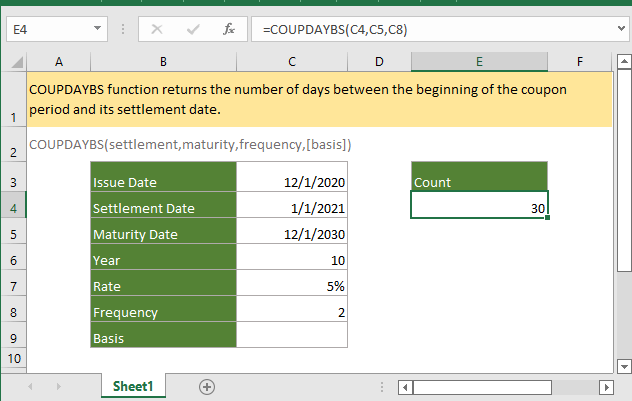Excel COUPDAYBS Function

If you want to follow along with this tutorial, please download the example spreadsheet.
Description
The COUPDAYBS function returns the number of days between the beginning of the coupon period and its settlement date.
Syntax and arguments
Formula syntax
Arguments
|
| Basis | Day Count |
| 0 or omitted | US (NASD) 30/360 |
| 1 | Actual/actual |
| 2 | Actual/360 |
| 3 | Actual/365 |
| 4 | European 30/360 |
Return Value
The DCOUNTA function returns a numeric value.
Errors
1. If the arguments settlement and maturity are not valid dates, such as are the non-numeric value, or the dates that are earlier than 1/1/1900, the function will return to an error value #VALUE!.
2. If the argument basis is out of range (0-4), the function will return to an error value #NUM!.
3. If the argument frequency is out of the number 1,2,4, the function will return to an error value #NUM!.
4. If the argument settlement date is later than maturity date, the function will return to an error value #NUM!.
Remarks
1. In Excel, dates are stored as serial number. Default, Excel is the 1/1/1900 system which means that 1/1/1900 is the first valid day in Excel and stored as number 1 in Excel. So 1/1/2021 is stored as number 44197.
2. All arguments are truncated to integers, if the arguments including time, the time will be ignored.
3. In the function, you should better use a date with cell reference or you can directly use DATE function embedded in the COUPDAYBS function as this:
=COUPDAYBS(DATE(2021,1,1),DATE(2030,12,1),2,0)
Version
Excel 2003 or later
Usage and Examples
Example basic usage
For instance, in the range B3:C9, it lists all information about a security. (a 10-year security is issued on 1st Dec, 2020, then be traded to buyer on 1st Jan, 2021 (settlement date), and the maturity date of the security would be 1st Dec, 2030, which is 10 years after the issued date (1st Dec, 2021), and its payments are twice per year.)
Now to count the days from the beginning of the security period until the settlement date, please use the formula as this:
=COUPDAYBS(C4,C5,C8)//here the basis is omitted
Press Enter key to get the result.
Relative Functions:
Excel ACCRINT Function
The ACCRINT function returns the accrued interest on periodic interest-paying securities.
Excel ACCRINTM Function
The ACCRINTM function returns the accrued interest for a security that pays interest at maturity.
Excel AMORDEGRC Function
The AMORDEGRC function returns the linear depreciation of an asset for each accounting period by applying a depreciation coefficient based on the lifetime of the assets.The Best Office Productivity Tools
Kutools for Excel - Helps You To Stand Out From Crowd
Use Kutools in your preferred language – supports English, Spanish, German, French, Chinese, and 40+ others!Kutools for Excel Boasts Over 300 Features, Ensuring That What You Need is Just A Click Away...
Office Tab - Enable Tabbed Reading and Editing in Microsoft Office (include Excel)
- One second to switch between dozens of open documents!
- Reduce hundreds of mouse clicks for you every day, say goodbye to mouse hand.
- Increases your productivity by 50% when viewing and editing multiple documents.
- Brings Efficient Tabs to Office (include Excel), Just Like Chrome, Edge and Firefox.